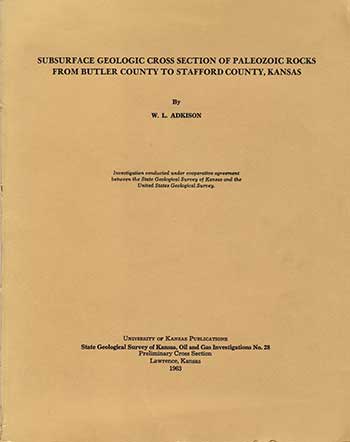Subsurface Geologic Cross Section of Paleozoic Rocks from Butler County to Stafford County, Kansas
DOI:
https://doi.org/10.17161/kgsbulletin.no..23588Abstract
The cross section extends across south-central Kansas from the Zenith-Peace Creek oil field on the southeastern flank of the Central Kansas Uplift in Stafford County eastward across the north-central part of the Sedgwick Basin to the Augusta oil field on the Nemaha Anticline in Butler County. Lithologic composition and general structural attitude of the Paleozoic rocks are shown by sample logs of 19 wells on sea level datum at a vertical scale of 1 inch equals 200 feet and a horizontal scale of 1 inch equals 3 miles. Detailed descriptions of the samples of each well are given in the appendix.
The Paleozoic rocks range in thickness from about 3,000 feet to at least 4,714 feet and represent all systems except the Silurian. Strata of Permian age, as much as 2,440 feet thick, consist mainly of shale in the upper part, anhydrite and salt in the middle part, and limestone, dolomite, and shale in the lower part. Rocks of Pennsylvanian age, 1,319 to 2,061 feet thick, are mostly limestone and shale but include some sandstone. In the eastern part of the cross section the Pennsylvanian rocks are subdivided in part into formations composed mainly of limestone or shale, but many of the stratigraphic contacts become obscure to the west because of a considerable increase in the percentage of limestone. Rocks of Mississippian age, 0 to 408 feet thick, are characterized by limestone and dolomite that is cherty in large part. The Chattanooga Shale of Devonian and Mississippian age is 0 to 226 feet thick and is chiefly shale. Strata of Ordovician age, about 570 to 615 feet thick, are mostly cherty dolomite but include some sandstone, shale, and limestone, mainly in the uppermost part. Rocks of Cambrian age, about 300 feet thick, are chiefly dolomite but include a basal sandstone as much as 60 feet thick. Precambrian rocks, penetrated in two wells, are mostly granite and quartzite.
Major structural features along the cross section include the Augusta Anticline, which is a part of the Nemaha Anticline, the southern end of the Voshell Anticline, arid the southeastern flank of the Central Kansas Uplift. These structures developed mainly after rocks of Mississippian age were deposited and before rocks of Des Moines age (Middle Pennsylvanian) were laid down. Strata of Des Moines age unconformably overlie rocks of Late Mississippian age in the central part of the cross section, the Chattanooga Shale at the western end, and rocks of Middle Ordovician age at the eastern end.
In the area adjacent to the cross section, oil and gas in commercial quantity was first discovered on the Augusta Anticline in 1914, and many other oil and gas fields have subsequently been found in this area. Within 2 miles of the line of the cross section, oil or gas is produced from rocks of Ordovician, Devonian, Mississippian, and Pennsylvanian ages, but the largest production has been from rocks of Ordovician age.

Published
Issue
Section
License
Copyright (c) 2025 W.L. Adkison

This work is licensed under a Creative Commons Attribution-NonCommercial 4.0 International License.
